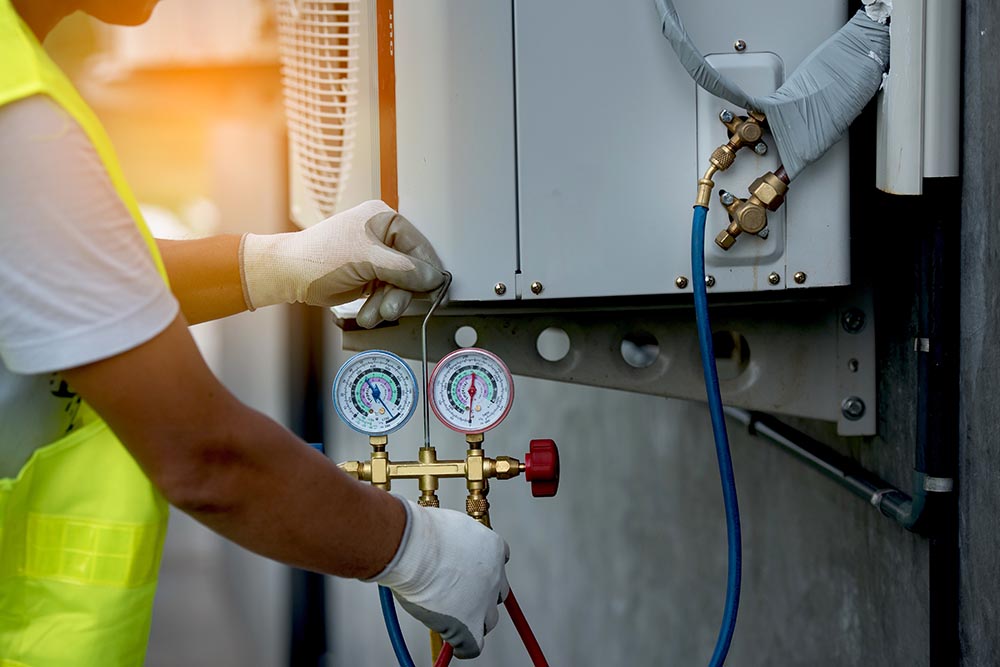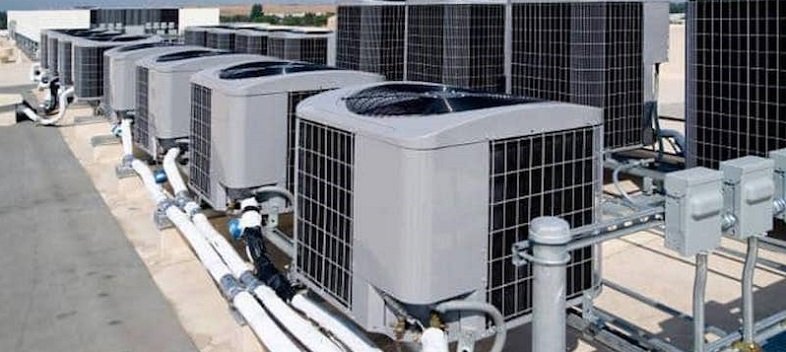How to Know It's Time for a furnace replacement
How to Know It's Time for a furnace replacement
Blog Article
Just How a Heatpump and Furnace Interact to Optimize Your Home's Home heating Effectiveness
Understanding just how a heatpump and furnace collaborate is crucial for property owners seeking effective home heating solutions. Each system has its staminas, offering a well balanced approach to home comfort. The warmth pump succeeds in moderate temperature levels, while the heating system delivers fast heat during severe cold. This harmony not only decreases energy costs yet additionally improves the lifespan of both home appliances. What aspects affect this partnership, and exactly how can property owners optimize their advantages?
Understanding Warmth Pumps: Exactly How They Work
Although several people might be strange with their inner functions, heatpump play an important role in modern-day furnace. These gadgets run by moving heat from one area to another, making use of the principles of thermodynamics. In chillier months, a heatpump extracts warm from the outdoors air, ground, or water, and transfers it inside to warm up the home. Alternatively, throughout warmer months, it can reverse the process, functioning as an air conditioning system by getting rid of warm from inside to the outside.Heat pumps include an evaporator, compressor, development, and condenser valve. The refrigerant within the system soaks up warm as it evaporates at low temperature levels and pressures. The compressor then enhances the pressure and temperature of the refrigerant, permitting it to release warmth as it condenses. This effective process can considerably decrease energy usage contrasted to typical heating methods, making warm pumps a sustainable selection for climate control in homes.
The Role of Heaters in Home Home Heating
Heating systems play an essential duty in home heating by offering a dependable source of warmth throughout the chillier months. They operate by producing warm through combustion or electric resistance, distributing it throughout the home using air ducts or radiant systems. The efficiency of a heater is usually gauged by its Annual Gas Application Efficiency (AFUE) score, which indicates just how properly the device transforms fuel into heat.Furnaces can use various energy resources, including gas, oil, electrical energy, or propane, allowing property owners to choose one of the most ideal choice for their demands. Unlike warm pumps, which may have a hard time in severe cold, heaters maintain regular performance, ensuring that indoor temperatures continue to be comfy no matter exterior conditions. Additionally, contemporary furnaces typically come furnished with innovative innovation, such as clever thermostats and variable-speed blowers, boosting their efficiency and responsiveness. This flexibility makes heating systems an important part in comprehensive home heating techniques.

Benefits of Utilizing Both Equipments With Each Other
Integrating the staminas of both heating systems and warm pumps can result in an extra reliable and efficient home heating remedy. Utilizing both systems allows home owners to capitalize on the heatpump's energy performance throughout milder temperature levels while counting on the heating system for more severe cold conditions. This double approach can substantially minimize power expenses, as heat pumps eat much less power than traditional home heating techniques when temperatures are moderate.Additionally, using both systems with each other can improve convenience levels in the home. Heatpump can provide regular, even home heating, while heaters can promptly elevate ambient temperature levels when needed. Additionally, the combination of both systems can prolong the lifespan of tools by decreasing wear and tear on each device, as they share the workload. Inevitably, property owners can enjoy a balanced, cost-efficient heating remedy that adjusts effortlessly to differing climate condition, guaranteeing a cozy and inviting home throughout the wintertime months.
How Warm Pumps and Furnaces Enhance Each Various Other
When home owners incorporate heatpump and heating systems, they develop a complementary heating unit that makes best use of efficiency and convenience. Heatpump operate by moving warm from the outdoors air or ground, making them extremely effective in moderate environments. They excel during milder temperature levels, supplying cost-efficient heating. On the other hand, heaters create warmth through combustion or electric resistance, supplying solid, immediate heat throughout severe chilly conditions.The mix of these 2 systems enables for dynamic changes based on temperature level variations. Throughout warmer months or milder winter season days, the warm pump can take the lead, saving energy and reducing prices. As temperatures drop, the heater can flawlessly involve, making sure constant warmth throughout the home. This harmony not just optimizes power usage yet likewise boosts the life expectancy of both systems, as each device runs within its optimal efficiency variety. Together, they develop a balanced atmosphere that adapts to differing climate needs.
Enhancing Performance: Tips for Homeowners
House owners can enhance their home heating efficiency with several useful approaches. Establishing a normal upkeep timetable, integrating clever thermostat modern technology, and applying effective insulation and sealing options are essential actions. These procedures not only boost comfort but likewise lower energy costs.
Normal Upkeep Schedule
To guarantee maximum home heating effectiveness, establishing a regular upkeep schedule is necessary for any kind of home. Homeowners ought to focus on routine inspections of both heatpump and furnaces to identify peak performance. This includes altering air filters every one to 3 months, as clogged filters can significantly reduce effectiveness. Furthermore, scheduling specialist maintenance at least yearly permits professionals to recognize and attend to prospective concerns before they intensify. Homeowners must also clean the warmth pump's exterior unit to stop particles buildup that can hinder air flow. By adhering to a normal upkeep schedule, property owners not only enhance their heating systems' efficiency however likewise extend their life expectancy, bring about greater convenience and reduced power expenses throughout the cooler months.
Smart Thermostat Assimilation
Incorporating a clever thermostat right into a home heater can substantially boost energy efficiency, specifically as it enables specific control over temperature setups. These devices can learn the homeowner's schedule and preferences, automatically adjusting the temperature to enhance convenience while lessening power use. They can decrease home heating throughout times when the home is empty, minimizing unnecessary intake. Lots of smart thermostats additionally offer real-time energy usage information, making it possible for home owners to make enlightened choices regarding their home heating practices. Additionally, remote gain access to through smartphone applications enables users to readjust settings from anywhere, making certain the home is warm upon return. Overall, clever thermostat combination not just improves comfort however substantially adds to power financial savings and effectiveness.
Insulation and Sealing Solutions
Smart thermostats play a crucial function in power effectiveness, yet their effectiveness can be significantly boosted by proper insulation and sealing remedies. Property owners need to prioritize protecting attic rooms, floorings, and wall surfaces to decrease warmth loss. High-grade insulation products, such as spray foam or fiberglass, can considerably improve thermal resistance. In addition, securing gaps around ducts, doors, and windows protects against cold air infiltration and heat escape. Weatherstripping and caulking work approaches for click here now addressing these leaks - heat pump service. Routine evaluations for air leakages, in addition to making use of blower door tests, can aid recognize problem areas. By buying insulation and securing, property owners can maximize the efficiency of their heating systems, eventually causing lowered energy consumption and reduced energy expenses
Common Myths About Warmth Pumps and Furnaces
What false impressions border warm pumps and furnaces? Lots of people wrongly believe that heatpump are inadequate in chillier environments. In truth, modern-day heatpump are made to operate successfully even in reduced temperature levels, offering reputable home heating throughout winter months. One more typical misconception is that furnaces are constantly extra efficient than heatpump. Nevertheless, this relies on the specific energy sources and efficiency rankings of the devices concerned. Some may likewise believe that utilizing both systems all at once is unneeded, but in fact, this mix can optimize home heating efficiency, particularly throughout severe climate condition. In addition, individuals typically think that heat pumps need constant maintenance, when actually, they have similar upkeep requires to standard heating systems. By unmasking these misconceptions, property owners can make more educated decisions concerning their heating options, inevitably leading to boosted convenience and energy performance in their homes.
Maintenance Considerations for Combined Systems

Frequently Asked Concerns
Can Warmth Pumps Work Successfully in Exceptionally Cold Climates?
Heatpump can have a hard time in extremely chilly climates due to minimized effectiveness and warm removal constraints. However, advancements in technology have brought about designs designed for better efficiency in such problems, enhancing their stability in rough environments.
The Length Of Time Do Warm Pumps and Furnaces Usually Last?
Heatpump generally last 15 to two decades, while furnaces have a life expectancy of 15 to three decades. Routine upkeep can prolong their durability, guaranteeing efficient procedure and lowering the demand for premature substitutes.

What Is the Ordinary Cost of Installing Both Equipments?
The average expense of mounting both a heatpump and a heating system generally varies between $5,000 to $10,000 - ductless mini splits. Variables affecting this cost consist of system dimension, installation intricacy, and regional labor rates
Are There Tax Obligation Motivations for Utilizing Energy-Efficient Home Heating Equipments?
Lots of property owners make inquiries concerning tax rewards for energy-efficient heating unit. Different government and state programs typically provide credit scores or rebates, encouraging the adoption of sustainable technologies to lower power usage and advertise ecological obligation.
Just how Do I Pick the Right Size Heatpump and Heater?
Selecting the appropriate size heatpump and heating system entails calculating the home's square video, thinking about insulation top quality, and reviewing neighborhood environment. Consulting a professional can ensure suitable system performance and energy efficiency based on specific requirements. furnace replacement. Recognizing exactly how a warm pump and heater job together is essential for house owners seeking efficient heating options. In cooler months, a warm pump removes heat from the outdoors air, ground, or water, and transfers it inside to warm the living area. When homeowners integrate heat pumps and heating systems, they create a complementary home heating system that makes best use of performance and convenience. Warm pumps run by transferring warm from the outside air or ground, making them click site very efficient in moderate climates. Warmth pumps can battle in exceptionally chilly climates due to lowered efficiency and warm removal restrictions
Report this page